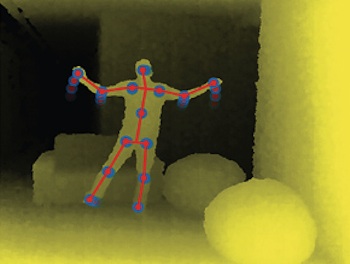Science Fiction
Dictionary
A B C D E F G H I J K L M N O P Q R S T U V W X Y Z
PrimeSense WAVI Xtion Gesture Control Of TV

PrimeSense's WAVI Xtion is a prototype system for controlling a television with gestures. PrimeSense is the company that developed the Kinect motion-tracking hardware for Microsoft.


( Technology created by PrimeSense tracks body movement in 3D )
While remote control unit manufacturers continuously crammed more and more functionality into a single hand-held apparatus, this functionality was unusable to the average user. It was as if the market need threshold was dramatically overshot by remote control technolog... In essence, because interaction with complex remote control functions is unnatural for most users, a usability gap resulted, leaving a vacant space for a new technology that could provide users with a more natural approach to control functionality.A hands-free, gesture-based control paradigm is the most-suitable natural interaction method. In recent years, this method has reached a consumer market price-performance point, where the user acquisition accuracy, resolution, robustness to ambient light, processing speed and cost have all passed the mass market threshold.
Low-cost, hands-free, gesture-based control is enabled via a three-dimensional view of the living room scene. While traditionally such a 3D view has been computationally expensive and therefore prohibitive to the consumer market, PrimeSense is now offering a consumer mass-market depth sensor that can provide hands-free control utilizing a computationally thin host.
Here's a quick look at a gesture-controlled menu selection prototype:
Douglas Adams wrote about the idea of gesture-controlled systems more than thirty years ago in his 1979 novel The Hitchhiker's Guide to the Galaxy. While he was att it, Adams also illustrated some potential problems with such a system:
The machine was rather difficult to operate. For years radios had been operated by means of pressing buttons and turning dials; then as the technology became more sophisticated the controls were made touch-sensitive--you merely had to brush the panels with your fingers; now all you had to do was wave your hand in the general direction of the components and hope. It saved a lot of muscular expenditure, of course, but meant that you had to sit infuriatingly still if you wanted to keep listening to the same program.Zaphod waved a hand and the channel switched again.
(Read more about the Gesture-Controlled Device )
From PrimeSense via Technology Review.
Scroll down for more stories in the same category. (Story submitted 1/21/2011)
Follow this kind of news @Technovelgy.| Email | RSS | Blog It | Stumble | del.icio.us | Digg | Reddit |
Would
you like to contribute a story tip?
It's easy:
Get the URL of the story, and the related sf author, and add
it here.
Comment/Join discussion ( 3 )
Related News Stories - (" Computer ")
Is Agentic AI The Wrong Kind Of Smartness?
'It’s smart enough to go wrong in very complicated ways, but not smart enough to help us find out what’s wrong.' - Isaac Asimov, 1975.
Jetson Orin Nano Super 70 Just $249
'Rayno folded up the microterm and tucked it back inside his jumper.' - Bruce Bethke, 1983.
Automatic Bot Traffic Is 38 Percent Of HTTP Requests
'there were so many worms and counterworms loose in the data-net...' - John Brunner, 1975
Neuroplatform Human Brain Organoid Bioprocessor Uses Less Electricity
'Cultured brains on a slab.'- Peter Watts, 1999
Technovelgy (that's tech-novel-gee!) is devoted to the creative science inventions and ideas of sf authors. Look for the Invention Category that interests you, the Glossary, the Invention Timeline, or see what's New.
Science Fiction
Timeline
1600-1899
1900-1939
1940's 1950's
1960's 1970's
1980's 1990's
2000's 2010's
Current News
Natural Gait With Prosthetic Connected To Nervous System
'The leg was to function, in a way, as a servo-mechanism operated by Larry’s brain...'
Woman Marries Computer, Vonnegut's Dream Comes True
'Men are made of protoplasm... Lasts forever.'
Spidery 'Walk Me' Toyota Autonomous Wheel Chair Like Star Wars
Walk along with the emperor.
Dancing Robots Taught Dance Moves
'A clockwork figure would be the thing for you...'
Proof Of Robothood - Not A Person
'Who are you people? - Show 'em.'
Indonesian Clans Battle
'The observation vehicle was of that peculiar variety used in conveying a large number of people across rough terrain.'
The 'Last Mile' In China Crowded With Delivery Robots
Yes, it's a delivery robot. On wheels.
Tornyol Microdrone Kills Mosquitoes
'The real border was defended by... a swarm of quasi-independent aerostats.'
PLATO Spacecraft, Hunter Of Habitable Planets, Now Ready
'I ... set my automatic astronomical instruments to searching for a habitable planet.'
Factory Humanoid Robots Built By Humanoid Robots
'...haven't you a section of the factory where only robot labor is employed?'
iPhone Air Fulfils Jobs' Promise From 2007 - A Giant Screen!
'... oblongs were all over the floor and surfaces.'
ChatGPT Now Participates in Group Chats
'...the city was their laboratory in human psychology.'
iPhone Pocket All Sold Out!
'A long, strong, slender net...'
Did The Yautja Have These First?
What a marvel of ingenuity the little device was!
Jetson ONE Air Races Begin, Can Air Polo Be Far Behind?
'If you're one of those rarities who haven't attended a rocket-polo "carnage", let me tell you it's a colorful affair.'
Will Space Stations Have Large Interior Spaces Again?
'They filed clumsily into the battleroom, like children in a swimming pool for the first time, clinging to the handholds along the side.'
